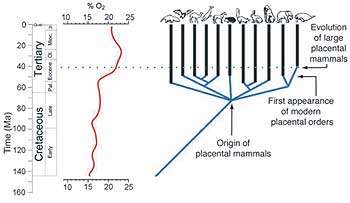Nothing Like Oxygen For That Evolutionary Boost

Paul Falkowski says that from an evolutionary point of view, the absence of dinosaurs has been a very good thing for large placental mammals – less competition and fewer nasty predators. But it is not the only reason large mammals, including humans, evolved: A sharp rise in the Earth’s atmospheric oxygen, about 15 million years after the extinction of the dinosaurs, gave mammals the evolutionary boost they needed to survive, thrive and, finally, dominate the planet, according to Falkowski, professor of geological and marine science, and lead author of a study published Sept. 30 in the journal Science.
Image above: The horizontal dotted line connects a concurrent increase in atmospheric oxygen to the rapid rise of large, placental mammals during the Eocene epoch.
Falkowski and his colleagues measured the abundance of carbon 13, a byproduct of photosynthesis, in deep-sea core samples dating back 205 million years. Because photosynthesis produces oxygen and leaves carbon 13 behind, the presence of carbon 13 in the fossil samples allows scientists to estimate precisely how much oxygen was in the atmosphere at any given time, Falkowski says.
From a steady 10 percent – the level at which dinosaurs flourished – the oxygen percentage rose to 17 percent 50 million years ago and then to 23 percent by 40 million years ago. The researchers found that the rise in oxygen content in the fossil record corresponded to the rapid rise of large, placental mammals. “The more oxygen, the bigger the mammals,” Falkowksi says. “We argue that the rise in oxygen content allowed mammals to become very, very large – mammals like 12-foot-tall sloths and huge saber-toothed cats. They paved the way for all subsequent large mammals, including ourselves.”
The results described in Falkowski’s article, “The Rise of Oxygen Over the Past 205 Million Years and the Evolution of Large Placental Mammals,” stem from years of analysis of organic and inorganic core samples. Scientists have been using deep-sea core samples for years, but Falkowski and his colleagues have achieved greater precision in their measurements, thanks to two high-precision, isotope ratio mass spectrometers housed in the geological sciences department at Rutgers.

Image left: Though big and small mammals now coexist, the balance shifted in favor of larger forms some 50 million years ago. Courtesy Georges Frei, www.upali.ch
There were placental mammals on Earth at the time of the great extinction of dinosaurs about 65 million years ago; they were, however, tiny, limited creatures. The extinction event itself, while eliminating the dinosaurs, did little to further the mammalian domination of the planet. It was the subsequent spreading of shallow seas, the increase in plant life – and photosynthesis – in addition to the consequent increase in oxygen content that gave the mammals the boost they needed, according to Falkowski.
In the last 10 million years, the percentage of oxygen in the Earth’s atmosphere has decreased to 21 percent. Falkowski says many scientists believed that great fires burned over the earth about 10 million years ago, reducing the number of trees, and, therefore, the amount of photosynthesis and oxygen.
Falkowski, recently named Board of Governors Professor of Geological and Marine Science, is a biologist and oceanographer by training. A native New Yorker and alumnus of the City College of New York (B.S. and M.S.; he received his doctoral degree from the University of British Columbia), Falkowski is director of the Environmental Biophysics and Molecular Ecology Laboratory at the Institute for Marine and Coastal Sciences, which he joined in 1998.
Source: Rutgers University















